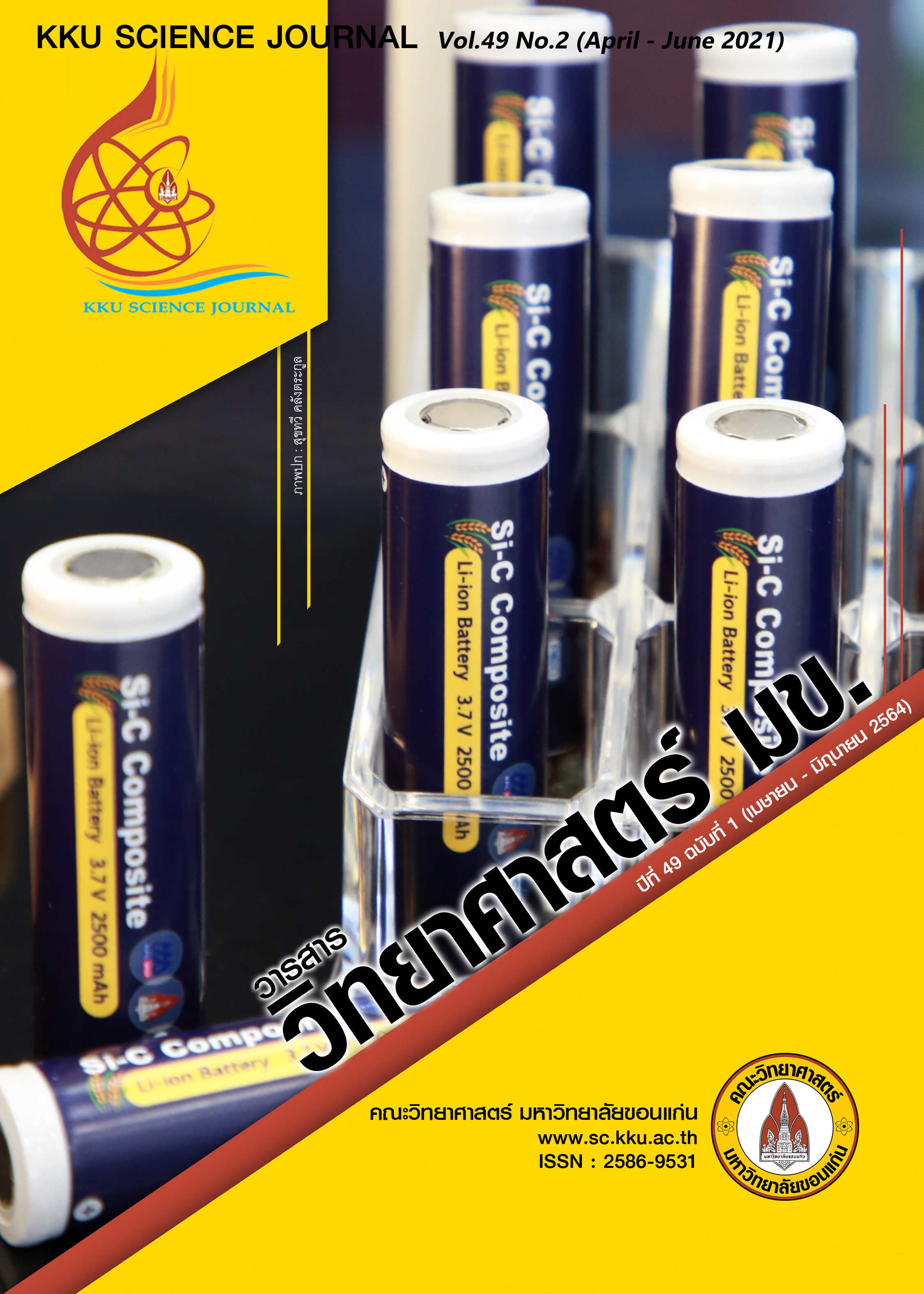Feeding Behavior of Sesarmid Crab, Episesarma mederi (H. Milne Edwards, 1853) (Decapoda; Sesarmidae) in the Mangrove of Pattani Bay, Thailand
Main Article Content
Abstract
Feeding behavior and stomach content of mangrove crab devote to the important information for their conservation measures and future aquaculture. Therefore, this study aimed to investigate the feed components of mangrove crab, Episesarma mederi (H. Milne Edwards, 1853) dwelling in mangrove forest around Pattani Bay in the South of Thailand. A total 360 mangrove crabs were monthly collected from the local fish landing port in 2013-2014. The crab samples were categorized into six groups based on body size and then their stomach contents were examined. The results showed that collecting mangrove crabs were mostly 25-50 mm on carapace width. The major dietary constituents, based on occurrence, were fish, mud sand, highly digested detritus, vegetation, crustacean, and polychaete. Based on frequency occurrence estimate volumetric (FOEV) technique; vegetation detritus, mud sand and highly digested detritus were the major trophic components comprising 60.08%, 10.52% and 9.40% of the total feed volumetric, respectively. Vegetation detritus was the major food group in all crab size groups. Our finding indicated that the E. mederi was a detritivore. In addition, male and female consumed closely food items. However, the animals were more favorite food during rainy season, whereas the vegetation detritus predominant occurred in dry season.
Article Details

This work is licensed under a Creative Commons Attribution-NonCommercial-NoDerivatives 4.0 International License.
References
Ashton, E.C. (2002). Mangrove sesarmid crab feeding experiments in Peninsular Malaysia. Journal of Experimental Marine Biology and Ecology 273: 97-119.
Dahdouh- Guebas, F., Giuggioli, M., Oluoch, A., Vannini, M. and Cannicci, S. (1999). Feeding habits of non- Ocypodid crabs from two mangrove forests in Kenya. Bulletin of Marine Science 64(2): 291-297.
Dahdouh- Guebas, F. , Verneirt, M. , Tack, J. F. and Koedam, N. (1997). Food preferences of Neosarmatium meinerti de Man (Decapoda: Sesarminae) and its possible effect on the regeneration of mangroves. Hydrobiologia 347: 83-89.
Fredrick, W.S., Allayie, S.A. and Ravichandran, S. (2013). Ecological variations in the feeding habits of some sesarmid crabs. Advances in Biological Research 7(5): 194-198.
Islam, M.S. and Uehara, T. (2008). Feeding habits of the sesarmid crab Perisesarma bidens (De Haan) in the mangroves of the Ryukyu Islands, Japan. Bangladesh Journal of Fisheries Research 12(2): 213-224.
Madambashi, A.M., Christofoletti, R.A. and Pinheiro, M.A.A. (2005). Natural diet of the crab Menippe nodifrons Stimpson, 1859 (Brachyura, Menippidae) in Paranapuã Beach, São Vicente (SP), Brasil. Nauplius 13(1): 77-82.
Masagca, J.T. (2009). Feeding ecology of tree-climbing mangrove sesarmid crabs from Luzon, Philippines. Biotropia 16(1): 1-10.
Micheli, F. (1993). Feeding ecology of mangrove crabs in North Eastern Australia: mangrove litter consumption by Sesarma messa and Sesarma smithii. Journal of Experimental Marine Biology and Ecology 171: 165-186.
Poovachiranon, S. and Tantichodok, P. (1991). The role of sesarmid crabs in the mineralization of leaf litter of Rhizophora apiculata in a mangrove, Southern Thailand. Phuket Marine Biological Center Research Bulletin 56: 63-74.
Schwamborn, R., Ekau, W., Silva, A.P., Schwamborn, S.H.L., Silva, T.A., Neumann-Leitão, S. and Saint-Paul, U. (2006). Ingestion of large centric diatoms, mangrove detritus, and zooplankton by zoeae of Aratus pisonii (Crustacea: Brachyura: Grapsidae). Hydrobiologia 560: 1-13.
Shelley, C. and Lovatelli, A. (2011). Mud crab aquaculture - A practical manual. FAO, Rome: FAO Fisheries and Aquaculture Technical Paper. 78 pp.
Squires, H.J. and Dawe, E.G. (2003). Stomach contents of Snow crab (Chionoecetes opilio, Decapoda, Brachyura) from the Northeast Newfoundland Shelf. Journal of Northwest Atlantic Fishery Science 32: 27-38.
Tiensongrasami, B. (2009). Mangrove crab and community mangrove forest issues. Thailand Research Fund (TRF). Bangkok. (in Thai)
Thongtham, N. and Kristensen, E. (2003). Physical and chemical characteristics of mangrove crab (Neoepisesarma versicolor) burrows in the Bangrong mangrove forest, Phuket, Thailand; with emphasis on behavioural response to changing environmental conditions. VieMilieu 53: 141-151.
Thongtham, N., Kristensen, E. and Puangprasan, S. (2008). Leaf removal by sesarmid crabs in Bangrong mangrove forest, Phuket, Thailand; with emphasis on the feeding ecology of Neoepisesarma versicolor. Estuarine, Coastal and Shelf Science 80: 573-580.
Williams, M.J. (1981). Methods for analysis of natural diet in portunid crabs (Crustacea: Decapoda: Portunidae). Journal of Experimental Marine Biology and Ecology 52: 103-113.


